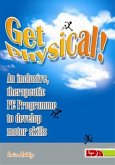R. Douglas Greer, Denise Ross
Verbal Behavior Analysis
Inducing and Expanding New Verbal Capabilities in Children with Language Delays
R. Douglas Greer, Denise Ross
Verbal Behavior Analysis
Inducing and Expanding New Verbal Capabilities in Children with Language Delays
- Broschiertes Buch
- Merkliste
- Auf die Merkliste
- Bewerten Bewerten
- Teilen
- Produkt teilen
- Produkterinnerung
- Produkterinnerung
Verbal Behavior Analysis describes newly identified tools to provide verbal capabilities to children who have language delays or who lack language. This book assists teachers and parents in their efforts to help children produce novel and spontaneous verbal functions, acquire language incidentally, and become socially verbal. This book responds to the large demand for effective language development tools for children with no language and severe language delays related to autism and other disabilities by providing practitioners with the means to advance verbal development. Step-by-step…mehr
Andere Kunden interessierten sich auch für
![SmiLE Therapy SmiLE Therapy]() Karin SchamrothSmiLE Therapy70,99 €
Karin SchamrothSmiLE Therapy70,99 €![The Essentials The Essentials]() Pamela BrillanteThe Essentials29,99 €
Pamela BrillanteThe Essentials29,99 €![Language and Literacy Disorders Language and Literacy Disorders]() Nickola NelsonLanguage and Literacy Disorders252,99 €
Nickola NelsonLanguage and Literacy Disorders252,99 €![Supporting Life Skills for Young Children with Vision Impairment and Other Disabilities Supporting Life Skills for Young Children with Vision Impairment and Other Disabilities]() Fiona BroadleySupporting Life Skills for Young Children with Vision Impairment and Other Disabilities48,99 €
Fiona BroadleySupporting Life Skills for Young Children with Vision Impairment and Other Disabilities48,99 €![Get Physical! Get Physical!]() Lois AddyGet Physical!19,99 €
Lois AddyGet Physical!19,99 €![Speech and Language Therapy Speech and Language Therapy]() Speech and Language Therapy62,99 €
Speech and Language Therapy62,99 €![Talkabout for Children 3 Talkabout for Children 3]() Alex Kelly (Managing director of Alex Kelly LtdTalkabout for Children 368,99 €
Alex Kelly (Managing director of Alex Kelly LtdTalkabout for Children 368,99 €-
-
-
Verbal Behavior Analysis describes newly identified tools to provide verbal capabilities to children who have language delays or who lack language. This book assists teachers and parents in their efforts to help children produce novel and spontaneous verbal functions, acquire language incidentally, and become socially verbal. This book responds to the large demand for effective language development tools for children with no language and severe language delays related to autism and other disabilities by providing practitioners with the means to advance verbal development. Step-by-step protocols describe how to move children from pre-listeners to listeners, non-speakers to speakers, speakers to readers and writers, and from non-social to socially verbal individuals. The procedures are derived from numerous experiments and applications with children in three countries, and are based on Skinner's (1957) theory of language function and on research findings that extended the theory to verbal development. The authors synthesize research published across several different journals, including many new findings, in ways that provide readers with the current state of the science of verbal behavior and its application to children with real needs. While the book emphasizes the vocal production of speech, the procedures are applicable to all forms of language (signs, pictures, voice-generating devices). The book includes an extensive glossary of terms from behavior analysis and verbal behavior analysis. The instructor's manual provides a course outline, quizzes, and protocols for training professionals to use the procedures with fidelity in applied settings. If you are a professor accustomed to receiving review copies, we regret that due to the limited number of appropriate courses we are unable to provide review copies of this title.
Hinweis: Dieser Artikel kann nur an eine deutsche Lieferadresse ausgeliefert werden.
Hinweis: Dieser Artikel kann nur an eine deutsche Lieferadresse ausgeliefert werden.
Produktdetails
- Produktdetails
- Verlag: Pearson Education (US)
- Seitenzahl: 336
- Erscheinungstermin: 8. Mai 2007
- Englisch
- Abmessung: 235mm x 180mm x 18mm
- Gewicht: 638g
- ISBN-13: 9780205458370
- ISBN-10: 0205458378
- Artikelnr.: 22516082
- Herstellerkennzeichnung
- Libri GmbH
- Europaallee 1
- 36244 Bad Hersfeld
- gpsr@libri.de
- Verlag: Pearson Education (US)
- Seitenzahl: 336
- Erscheinungstermin: 8. Mai 2007
- Englisch
- Abmessung: 235mm x 180mm x 18mm
- Gewicht: 638g
- ISBN-13: 9780205458370
- ISBN-10: 0205458378
- Artikelnr.: 22516082
- Herstellerkennzeichnung
- Libri GmbH
- Europaallee 1
- 36244 Bad Hersfeld
- gpsr@libri.de
Doug Greer is Professor of Education and Psychology and Coordinator of the Programs in Behavior Analysis at Columbia University, Teachers College and the Graduate School of Arts and Sciences, where he has taught for 37 years. He is the author of over 120 research reports (27 on verbal behavior analysis) and conceptual publications in 25 different journals, as well as 12 books, and he has sponsored 130 doctoral dissertations. Greer is a Fellow of the Association for Behavior Analysis and is the recipient of: (a) the American Psychology Association’s Fed S. Keller Award for Distinguished Contributions to Education, (b) The Association for Behavior Analysis award for Distinguished Contributions to the International Dissemination of Behavior Analysis, the designation of May 5 as the R. Douglas Greer day for Westchester County by the Westchester Legislature, and Distinguished Contributions to the Fred S. Keller School by The Fred S. Keller School. He is a CABAS® Board certified as a Senior Behavior Analyst and a Senior Research Scientist and has assisted in the development of CABAS® School in the USA, Ireland, England, and Italy. His research interests have included verbal behavior analysis, the development of verbal behavior, a learner-driven science of teaching and the organizational behavior analytic procedures to support that system, pediatric behavioral medicine, a behavioral psychology of music, and the induction of and applications of observational learning. He has served on the editorial boards of Journal of Applied Behavior Analysis, Journal of Behavioral Education, In Segnare all' Handicappato, Journal of Early and Intensive Behavioral Interventions (Associate Editor), European Journal of Behavior Analysis, The American Psychologist, Verplanck’s Glossary and Thesaurus of The Science of Behavior, The Behavior Analyst, American Journal of Mental Deficiency, Bulletin of the Council for Research in Music Education, and the Journal of Music Therapy. Greer has served as distinguished visiting professor at five universities in Spain (Cadiz, Almeria, Oviedo, Grenada, and Salamanca), a higher education programs in applied behavior analysis in Norway, and has lectured at the University of Wales at Bangor. He has presented keynote addresses at conferences on behavior analysis in Canada, Israel, Nigeria, Japan, Spain, Ireland, England, Brazil, Norway, Italy, Taiwan, and Korea. Denise E. Ross is an associate professor of psychology and education in the Programs for Applied Behavior Analysis at Teachers College, Columbia University. She completed her PhD at Columbia University in 1998 and taught at Florida Atlantic University before joining Teachers College in 2002. Her research on verbal behavior and children with autism and other developmental disabilities has been published in Education and Training in Developmental Disabilities, Research in Developmental Disabilities, the Journal of Behavioral Education, The Behavior Analyst Today, Journal of Early and Intensive Behavioral Interventions, and the Analysis of Verbal Behavior.
Chapter 1: Verbal Behavior Analysis and Verbal Development
Introduction to Verbal Behavior Analysis
The Relation Between Verbal Behavior Analysis and Basic and Applied
Behavior Analysis
Protocols for Inducing New Verbal Capabilities
Selecting a Verbal Topography: Linguistic and Verbal Behavior Contributions
Research in Verbal Behavior Analysis
Developmental Milestones in Verbal Behavior
Chapter 1 Summary
Chapter 1 Endnotes
Chapter 2: Teaching and Learning Verbal Operants and Verbal Developmental
Capabilities: Definitions and Measurement
Selecting Verbal Forms and Functions for Instruction
Conducting and Recording Probes
Probe Mastery Criterion, Data Collection and Graphing
Presenting and Measuring Learn Units
Presenting Learn Units
Recording and Graphing Verbal Behavior
Training Graphs
Generalization Graphs
Providing and Measuring Accurate Instructional Decisions
Research Based Tactics for Intervention
General Tactics
Generic Pre-Listener-to-Speaker Tactics
Generic Tactics for Children with Reader-Writer Capabilities
Generic Tactics for Teaching Teachers, Parents, and Behavior Analysts
The Learn Unit Context and Learn Unit Components
The Decision Protocol: An Algorithm for Analyzing the Source of Learning
Obstacles
Identification of Decision Opportunities
Trend Determination
Learn Unit Context Analysis
Selection of the Tactic
Implementation of the Tactic
Details of the Analytic Algorithm
Strategic Questions to Ask about Motivational Conditions and Setting
Events
Strategic Questions to Ask about Instructional Histories and
Prerequisite Repertoires
Prerequisite stimulus control
Measuring and Recording Developmental Milestones
Defining Verbal Milestones
Chapter 2 Summary
Chapter 3: Learning to Listen: Induction of the Listener Repertoire of
Verbal Development
The Listener Role in Verbal Behavior
Instructional Sequence for Teaching Listener Repertoires
Basic Listener Literacy
Sequence of Interventions to Induce Basic Listener Literacy (Table
3.1)
Developing Initial Instructional Control: Five Basic Attentional
Programs
Protocol Description for the Five Basic Attentional Programs
The Five Attentional Programs: Attention Control to Teacher
Listener Emersion Protocol to Develop Vowel-Consonant Control for
Listener Responses
Other Prerequisites to Basic Listener Literacy
Establishing Visual Tracking through Conditioning Eye Contact to
Stimuli
Sensory Matching or Establishing The Capacity for Sameness across
Senses
Conditioning Voices as Reinforcers
Auditory Matching of Words
Auditory Matching Steps
Inducing the Listener Component of Naming
Chapter 3 Summary
Chapter 3 Endnotes
Chapter 4: Basic Teaching Operations for Early Speaker Functions
The Behavioral Functions of the Speaker
Parroting and Echoics
Establishing Operations and Mands
Tacts
Similarities and Differences between Mand and Tact Instruction
Echoic-to-Mand-Procedure (Level 1 of Mand Training)
Mand Function Instruction (Level 2 of Mand Instruction)
Echoic to Tact Training (Level 1 of Tact Training)
Tact Teaching Sequence (Level 2 of Tact Training)
Autoclitics with Mands and Tacts
Alternative Procedures for Teaching Echoic-to-Mand and Echoic-to-Tact
Responses
Stimulus-stimulus Pairing Procedure
Rapid Motor Imitation
Speaker Immersion
Inducing Transformation of Establishing Operations Across Mand and Tact
Functions
Naming
Basic Visual Discrimination to Occasion the Advancement of Speaker and
Listener Repertoires
Inducing Full Naming
The Importance of Tacts
Procedures for Rapid Expansion of Tacts through Direct Contact with Learn
Units
Chapter 4 Summary
Chapter 4 Endnotes
Chapter 5: Inducing Advanced Speaker Functions and Correcting Faulty Vocal
Behavior
Advancing Key Verbal Capabilities
Inducing and Expanding Tact and Intraverbal Capabilties
Tact Capabilities
Intraverbal Capabilities
Capability 1: Acquisition of new tacts by direct learn units
Capability 2: Recruitment of new tacts by using "wh" and "how" questions
Capability 3: Acquisition of new tacts incidentally via naming
Capability 4: Learning tacts from observation or indirect contact with
contingencies received by others
Learning Tacts from Observation
Instructional Procedure for Teaching Observational Learning of Tacts
(Developing Tacts by Observing Others Receive Learn Units)
Pre and Post-Intervention Evaluation Probes for Observational
Learning of Tacts
Yoked-contingency interventions
Joint Yoked-contingency and Peer Monitoring Protocol
Intraverbal Capabilities and Social Interaction
Conversational Units
Capability 5: Learning Intraverbal Functions of Self-Talk
Capability 6: Acquisition of conversational units and related
speaker-listener exchanged
Pre and Post Assessment for Conversational Units and Sequilics
Acquiring the Listener Reinforcement Component of Social Exchanges
General Game Board Description and Set-up
Part 1: I spy, 20 questions
Part 2-- 20 Questions: Tact and textual response
Part 3-- Bingo
Part 4-- Peer tutoring with the game board
Part 5-- Group instruction with the game board
Part 6-- Teaching empathy ("What can you do to help" program)
Capability 7: Learning deictic functions or taking the perspective of
others
Deictic Probes
Production program for emission of appropriate talking
Replacing Echolalia and Palilalia with Functional Verbal Behavior
Fixing Improperly Learned Control of Echoic Responses
Textual Test and Textual Stimulus Prompt Protocol
Auditory Matching to Correct Faulty Echoic Responding
Replacing Vocal Stereotypy with Functional Verbal Behavior
Assessing the function of vocal stereotypy
Tact Protocol to Replace Palilalia
Chapter 5 Summary
Chapter 5 Endnotes
Chapter 6: Reading and Writing: Print-Goverened and Print-Governing Verbal
Behavior
Scope and Purpose of the Print Control Chapter
Book Conditioning Protocol
Stimulus-Stimulus Pairing Training/Test Trials for Conditioning Stimuli
as Reinforcers for Observi
Probes for Conditioning Reinforcement for Observing Books
Word-Picture Discrimination and Matching
Tactics for Teaching Word-Picture and Matching Discrimination
Using the Edmark ® Reading Series
Reading Comprehension from Hearing One's Own Textual Responses
Multiple Exemplar Instruction Auditory and Visual Components of
Reading Responses
Adding Print Stimuli to the Joint Control over Speaker and Listener
Responding in the Naming Capability
Phonetic Reading for Textual Responding: Acquiring the Topography
Using the Auditory Matching Protocol in Solving Phonetic Reading
Difficulties
Motivational Functions of Reading and Writing
Establishing the "Need to Read"
Establishing the Topography of Writing
Establishing the "Need to Write"
Chapter 6 Summary
Chapter 7
Problems in Verbal Development, Current Solutions, and a Trajectory for
More Solutions
Foundations of Speaker and Listener Capabilities
When Attention to Teacher is Missing
When Attention to Instructional Stimuli is Missing
When the Capacity for Sameness is Missing
When the Capability to be reinforced for attention to adult voices
is missing
Capability for Emitting Speaker Verbal Operants
When the Capability To Match Consonant/Vowel Combinations Of Spoken
Words Is Missing Or Speech Is Faulty
When Basic Listener Literacy Is Missing
When there are Few Tacts in Repertoire: Expand the Tact Repertoire
The Listener Capability Of Naming Is Missing; Implement The
Multiple Exemplar Protocol For The Listener Component Of Naming
When Capability For Observational Learning of Tacts Is Missing
When the Capability of Observational Learning of Tacts is Missing
Fixing Faulty Echoic and Intraverbal Repertoires
Joining Speaker and Listener Capabilities
Speaker-as-own-listener
How to Expand Tacts Before Naming is Present Continue Rapid
Expansion of the Tact Repertoire
Observational learning of tacts and the “Wh” repertoire
Expanding observational learning of tacts and the observational
learning capability
Inducing Observational Learning if it is Missing
Stages of Verbal Development
A Note on Scientific Evidence
Some Suggested Areas of Further Research
Introduction to Verbal Behavior Analysis
The Relation Between Verbal Behavior Analysis and Basic and Applied
Behavior Analysis
Protocols for Inducing New Verbal Capabilities
Selecting a Verbal Topography: Linguistic and Verbal Behavior Contributions
Research in Verbal Behavior Analysis
Developmental Milestones in Verbal Behavior
Chapter 1 Summary
Chapter 1 Endnotes
Chapter 2: Teaching and Learning Verbal Operants and Verbal Developmental
Capabilities: Definitions and Measurement
Selecting Verbal Forms and Functions for Instruction
Conducting and Recording Probes
Probe Mastery Criterion, Data Collection and Graphing
Presenting and Measuring Learn Units
Presenting Learn Units
Recording and Graphing Verbal Behavior
Training Graphs
Generalization Graphs
Providing and Measuring Accurate Instructional Decisions
Research Based Tactics for Intervention
General Tactics
Generic Pre-Listener-to-Speaker Tactics
Generic Tactics for Children with Reader-Writer Capabilities
Generic Tactics for Teaching Teachers, Parents, and Behavior Analysts
The Learn Unit Context and Learn Unit Components
The Decision Protocol: An Algorithm for Analyzing the Source of Learning
Obstacles
Identification of Decision Opportunities
Trend Determination
Learn Unit Context Analysis
Selection of the Tactic
Implementation of the Tactic
Details of the Analytic Algorithm
Strategic Questions to Ask about Motivational Conditions and Setting
Events
Strategic Questions to Ask about Instructional Histories and
Prerequisite Repertoires
Prerequisite stimulus control
Measuring and Recording Developmental Milestones
Defining Verbal Milestones
Chapter 2 Summary
Chapter 3: Learning to Listen: Induction of the Listener Repertoire of
Verbal Development
The Listener Role in Verbal Behavior
Instructional Sequence for Teaching Listener Repertoires
Basic Listener Literacy
Sequence of Interventions to Induce Basic Listener Literacy (Table
3.1)
Developing Initial Instructional Control: Five Basic Attentional
Programs
Protocol Description for the Five Basic Attentional Programs
The Five Attentional Programs: Attention Control to Teacher
Listener Emersion Protocol to Develop Vowel-Consonant Control for
Listener Responses
Other Prerequisites to Basic Listener Literacy
Establishing Visual Tracking through Conditioning Eye Contact to
Stimuli
Sensory Matching or Establishing The Capacity for Sameness across
Senses
Conditioning Voices as Reinforcers
Auditory Matching of Words
Auditory Matching Steps
Inducing the Listener Component of Naming
Chapter 3 Summary
Chapter 3 Endnotes
Chapter 4: Basic Teaching Operations for Early Speaker Functions
The Behavioral Functions of the Speaker
Parroting and Echoics
Establishing Operations and Mands
Tacts
Similarities and Differences between Mand and Tact Instruction
Echoic-to-Mand-Procedure (Level 1 of Mand Training)
Mand Function Instruction (Level 2 of Mand Instruction)
Echoic to Tact Training (Level 1 of Tact Training)
Tact Teaching Sequence (Level 2 of Tact Training)
Autoclitics with Mands and Tacts
Alternative Procedures for Teaching Echoic-to-Mand and Echoic-to-Tact
Responses
Stimulus-stimulus Pairing Procedure
Rapid Motor Imitation
Speaker Immersion
Inducing Transformation of Establishing Operations Across Mand and Tact
Functions
Naming
Basic Visual Discrimination to Occasion the Advancement of Speaker and
Listener Repertoires
Inducing Full Naming
The Importance of Tacts
Procedures for Rapid Expansion of Tacts through Direct Contact with Learn
Units
Chapter 4 Summary
Chapter 4 Endnotes
Chapter 5: Inducing Advanced Speaker Functions and Correcting Faulty Vocal
Behavior
Advancing Key Verbal Capabilities
Inducing and Expanding Tact and Intraverbal Capabilties
Tact Capabilities
Intraverbal Capabilities
Capability 1: Acquisition of new tacts by direct learn units
Capability 2: Recruitment of new tacts by using "wh" and "how" questions
Capability 3: Acquisition of new tacts incidentally via naming
Capability 4: Learning tacts from observation or indirect contact with
contingencies received by others
Learning Tacts from Observation
Instructional Procedure for Teaching Observational Learning of Tacts
(Developing Tacts by Observing Others Receive Learn Units)
Pre and Post-Intervention Evaluation Probes for Observational
Learning of Tacts
Yoked-contingency interventions
Joint Yoked-contingency and Peer Monitoring Protocol
Intraverbal Capabilities and Social Interaction
Conversational Units
Capability 5: Learning Intraverbal Functions of Self-Talk
Capability 6: Acquisition of conversational units and related
speaker-listener exchanged
Pre and Post Assessment for Conversational Units and Sequilics
Acquiring the Listener Reinforcement Component of Social Exchanges
General Game Board Description and Set-up
Part 1: I spy, 20 questions
Part 2-- 20 Questions: Tact and textual response
Part 3-- Bingo
Part 4-- Peer tutoring with the game board
Part 5-- Group instruction with the game board
Part 6-- Teaching empathy ("What can you do to help" program)
Capability 7: Learning deictic functions or taking the perspective of
others
Deictic Probes
Production program for emission of appropriate talking
Replacing Echolalia and Palilalia with Functional Verbal Behavior
Fixing Improperly Learned Control of Echoic Responses
Textual Test and Textual Stimulus Prompt Protocol
Auditory Matching to Correct Faulty Echoic Responding
Replacing Vocal Stereotypy with Functional Verbal Behavior
Assessing the function of vocal stereotypy
Tact Protocol to Replace Palilalia
Chapter 5 Summary
Chapter 5 Endnotes
Chapter 6: Reading and Writing: Print-Goverened and Print-Governing Verbal
Behavior
Scope and Purpose of the Print Control Chapter
Book Conditioning Protocol
Stimulus-Stimulus Pairing Training/Test Trials for Conditioning Stimuli
as Reinforcers for Observi
Probes for Conditioning Reinforcement for Observing Books
Word-Picture Discrimination and Matching
Tactics for Teaching Word-Picture and Matching Discrimination
Using the Edmark ® Reading Series
Reading Comprehension from Hearing One's Own Textual Responses
Multiple Exemplar Instruction Auditory and Visual Components of
Reading Responses
Adding Print Stimuli to the Joint Control over Speaker and Listener
Responding in the Naming Capability
Phonetic Reading for Textual Responding: Acquiring the Topography
Using the Auditory Matching Protocol in Solving Phonetic Reading
Difficulties
Motivational Functions of Reading and Writing
Establishing the "Need to Read"
Establishing the Topography of Writing
Establishing the "Need to Write"
Chapter 6 Summary
Chapter 7
Problems in Verbal Development, Current Solutions, and a Trajectory for
More Solutions
Foundations of Speaker and Listener Capabilities
When Attention to Teacher is Missing
When Attention to Instructional Stimuli is Missing
When the Capacity for Sameness is Missing
When the Capability to be reinforced for attention to adult voices
is missing
Capability for Emitting Speaker Verbal Operants
When the Capability To Match Consonant/Vowel Combinations Of Spoken
Words Is Missing Or Speech Is Faulty
When Basic Listener Literacy Is Missing
When there are Few Tacts in Repertoire: Expand the Tact Repertoire
The Listener Capability Of Naming Is Missing; Implement The
Multiple Exemplar Protocol For The Listener Component Of Naming
When Capability For Observational Learning of Tacts Is Missing
When the Capability of Observational Learning of Tacts is Missing
Fixing Faulty Echoic and Intraverbal Repertoires
Joining Speaker and Listener Capabilities
Speaker-as-own-listener
How to Expand Tacts Before Naming is Present Continue Rapid
Expansion of the Tact Repertoire
Observational learning of tacts and the “Wh” repertoire
Expanding observational learning of tacts and the observational
learning capability
Inducing Observational Learning if it is Missing
Stages of Verbal Development
A Note on Scientific Evidence
Some Suggested Areas of Further Research
Chapter 1: Verbal Behavior Analysis and Verbal Development
Introduction to Verbal Behavior Analysis
The Relation Between Verbal Behavior Analysis and Basic and Applied
Behavior Analysis
Protocols for Inducing New Verbal Capabilities
Selecting a Verbal Topography: Linguistic and Verbal Behavior Contributions
Research in Verbal Behavior Analysis
Developmental Milestones in Verbal Behavior
Chapter 1 Summary
Chapter 1 Endnotes
Chapter 2: Teaching and Learning Verbal Operants and Verbal Developmental
Capabilities: Definitions and Measurement
Selecting Verbal Forms and Functions for Instruction
Conducting and Recording Probes
Probe Mastery Criterion, Data Collection and Graphing
Presenting and Measuring Learn Units
Presenting Learn Units
Recording and Graphing Verbal Behavior
Training Graphs
Generalization Graphs
Providing and Measuring Accurate Instructional Decisions
Research Based Tactics for Intervention
General Tactics
Generic Pre-Listener-to-Speaker Tactics
Generic Tactics for Children with Reader-Writer Capabilities
Generic Tactics for Teaching Teachers, Parents, and Behavior Analysts
The Learn Unit Context and Learn Unit Components
The Decision Protocol: An Algorithm for Analyzing the Source of Learning
Obstacles
Identification of Decision Opportunities
Trend Determination
Learn Unit Context Analysis
Selection of the Tactic
Implementation of the Tactic
Details of the Analytic Algorithm
Strategic Questions to Ask about Motivational Conditions and Setting
Events
Strategic Questions to Ask about Instructional Histories and
Prerequisite Repertoires
Prerequisite stimulus control
Measuring and Recording Developmental Milestones
Defining Verbal Milestones
Chapter 2 Summary
Chapter 3: Learning to Listen: Induction of the Listener Repertoire of
Verbal Development
The Listener Role in Verbal Behavior
Instructional Sequence for Teaching Listener Repertoires
Basic Listener Literacy
Sequence of Interventions to Induce Basic Listener Literacy (Table
3.1)
Developing Initial Instructional Control: Five Basic Attentional
Programs
Protocol Description for the Five Basic Attentional Programs
The Five Attentional Programs: Attention Control to Teacher
Listener Emersion Protocol to Develop Vowel-Consonant Control for
Listener Responses
Other Prerequisites to Basic Listener Literacy
Establishing Visual Tracking through Conditioning Eye Contact to
Stimuli
Sensory Matching or Establishing The Capacity for Sameness across
Senses
Conditioning Voices as Reinforcers
Auditory Matching of Words
Auditory Matching Steps
Inducing the Listener Component of Naming
Chapter 3 Summary
Chapter 3 Endnotes
Chapter 4: Basic Teaching Operations for Early Speaker Functions
The Behavioral Functions of the Speaker
Parroting and Echoics
Establishing Operations and Mands
Tacts
Similarities and Differences between Mand and Tact Instruction
Echoic-to-Mand-Procedure (Level 1 of Mand Training)
Mand Function Instruction (Level 2 of Mand Instruction)
Echoic to Tact Training (Level 1 of Tact Training)
Tact Teaching Sequence (Level 2 of Tact Training)
Autoclitics with Mands and Tacts
Alternative Procedures for Teaching Echoic-to-Mand and Echoic-to-Tact
Responses
Stimulus-stimulus Pairing Procedure
Rapid Motor Imitation
Speaker Immersion
Inducing Transformation of Establishing Operations Across Mand and Tact
Functions
Naming
Basic Visual Discrimination to Occasion the Advancement of Speaker and
Listener Repertoires
Inducing Full Naming
The Importance of Tacts
Procedures for Rapid Expansion of Tacts through Direct Contact with Learn
Units
Chapter 4 Summary
Chapter 4 Endnotes
Chapter 5: Inducing Advanced Speaker Functions and Correcting Faulty Vocal
Behavior
Advancing Key Verbal Capabilities
Inducing and Expanding Tact and Intraverbal Capabilties
Tact Capabilities
Intraverbal Capabilities
Capability 1: Acquisition of new tacts by direct learn units
Capability 2: Recruitment of new tacts by using "wh" and "how" questions
Capability 3: Acquisition of new tacts incidentally via naming
Capability 4: Learning tacts from observation or indirect contact with
contingencies received by others
Learning Tacts from Observation
Instructional Procedure for Teaching Observational Learning of Tacts
(Developing Tacts by Observing Others Receive Learn Units)
Pre and Post-Intervention Evaluation Probes for Observational
Learning of Tacts
Yoked-contingency interventions
Joint Yoked-contingency and Peer Monitoring Protocol
Intraverbal Capabilities and Social Interaction
Conversational Units
Capability 5: Learning Intraverbal Functions of Self-Talk
Capability 6: Acquisition of conversational units and related
speaker-listener exchanged
Pre and Post Assessment for Conversational Units and Sequilics
Acquiring the Listener Reinforcement Component of Social Exchanges
General Game Board Description and Set-up
Part 1: I spy, 20 questions
Part 2-- 20 Questions: Tact and textual response
Part 3-- Bingo
Part 4-- Peer tutoring with the game board
Part 5-- Group instruction with the game board
Part 6-- Teaching empathy ("What can you do to help" program)
Capability 7: Learning deictic functions or taking the perspective of
others
Deictic Probes
Production program for emission of appropriate talking
Replacing Echolalia and Palilalia with Functional Verbal Behavior
Fixing Improperly Learned Control of Echoic Responses
Textual Test and Textual Stimulus Prompt Protocol
Auditory Matching to Correct Faulty Echoic Responding
Replacing Vocal Stereotypy with Functional Verbal Behavior
Assessing the function of vocal stereotypy
Tact Protocol to Replace Palilalia
Chapter 5 Summary
Chapter 5 Endnotes
Chapter 6: Reading and Writing: Print-Goverened and Print-Governing Verbal
Behavior
Scope and Purpose of the Print Control Chapter
Book Conditioning Protocol
Stimulus-Stimulus Pairing Training/Test Trials for Conditioning Stimuli
as Reinforcers for Observi
Probes for Conditioning Reinforcement for Observing Books
Word-Picture Discrimination and Matching
Tactics for Teaching Word-Picture and Matching Discrimination
Using the Edmark ® Reading Series
Reading Comprehension from Hearing One's Own Textual Responses
Multiple Exemplar Instruction Auditory and Visual Components of
Reading Responses
Adding Print Stimuli to the Joint Control over Speaker and Listener
Responding in the Naming Capability
Phonetic Reading for Textual Responding: Acquiring the Topography
Using the Auditory Matching Protocol in Solving Phonetic Reading
Difficulties
Motivational Functions of Reading and Writing
Establishing the "Need to Read"
Establishing the Topography of Writing
Establishing the "Need to Write"
Chapter 6 Summary
Chapter 7
Problems in Verbal Development, Current Solutions, and a Trajectory for
More Solutions
Foundations of Speaker and Listener Capabilities
When Attention to Teacher is Missing
When Attention to Instructional Stimuli is Missing
When the Capacity for Sameness is Missing
When the Capability to be reinforced for attention to adult voices
is missing
Capability for Emitting Speaker Verbal Operants
When the Capability To Match Consonant/Vowel Combinations Of Spoken
Words Is Missing Or Speech Is Faulty
When Basic Listener Literacy Is Missing
When there are Few Tacts in Repertoire: Expand the Tact Repertoire
The Listener Capability Of Naming Is Missing; Implement The
Multiple Exemplar Protocol For The Listener Component Of Naming
When Capability For Observational Learning of Tacts Is Missing
When the Capability of Observational Learning of Tacts is Missing
Fixing Faulty Echoic and Intraverbal Repertoires
Joining Speaker and Listener Capabilities
Speaker-as-own-listener
How to Expand Tacts Before Naming is Present Continue Rapid
Expansion of the Tact Repertoire
Observational learning of tacts and the “Wh” repertoire
Expanding observational learning of tacts and the observational
learning capability
Inducing Observational Learning if it is Missing
Stages of Verbal Development
A Note on Scientific Evidence
Some Suggested Areas of Further Research
Introduction to Verbal Behavior Analysis
The Relation Between Verbal Behavior Analysis and Basic and Applied
Behavior Analysis
Protocols for Inducing New Verbal Capabilities
Selecting a Verbal Topography: Linguistic and Verbal Behavior Contributions
Research in Verbal Behavior Analysis
Developmental Milestones in Verbal Behavior
Chapter 1 Summary
Chapter 1 Endnotes
Chapter 2: Teaching and Learning Verbal Operants and Verbal Developmental
Capabilities: Definitions and Measurement
Selecting Verbal Forms and Functions for Instruction
Conducting and Recording Probes
Probe Mastery Criterion, Data Collection and Graphing
Presenting and Measuring Learn Units
Presenting Learn Units
Recording and Graphing Verbal Behavior
Training Graphs
Generalization Graphs
Providing and Measuring Accurate Instructional Decisions
Research Based Tactics for Intervention
General Tactics
Generic Pre-Listener-to-Speaker Tactics
Generic Tactics for Children with Reader-Writer Capabilities
Generic Tactics for Teaching Teachers, Parents, and Behavior Analysts
The Learn Unit Context and Learn Unit Components
The Decision Protocol: An Algorithm for Analyzing the Source of Learning
Obstacles
Identification of Decision Opportunities
Trend Determination
Learn Unit Context Analysis
Selection of the Tactic
Implementation of the Tactic
Details of the Analytic Algorithm
Strategic Questions to Ask about Motivational Conditions and Setting
Events
Strategic Questions to Ask about Instructional Histories and
Prerequisite Repertoires
Prerequisite stimulus control
Measuring and Recording Developmental Milestones
Defining Verbal Milestones
Chapter 2 Summary
Chapter 3: Learning to Listen: Induction of the Listener Repertoire of
Verbal Development
The Listener Role in Verbal Behavior
Instructional Sequence for Teaching Listener Repertoires
Basic Listener Literacy
Sequence of Interventions to Induce Basic Listener Literacy (Table
3.1)
Developing Initial Instructional Control: Five Basic Attentional
Programs
Protocol Description for the Five Basic Attentional Programs
The Five Attentional Programs: Attention Control to Teacher
Listener Emersion Protocol to Develop Vowel-Consonant Control for
Listener Responses
Other Prerequisites to Basic Listener Literacy
Establishing Visual Tracking through Conditioning Eye Contact to
Stimuli
Sensory Matching or Establishing The Capacity for Sameness across
Senses
Conditioning Voices as Reinforcers
Auditory Matching of Words
Auditory Matching Steps
Inducing the Listener Component of Naming
Chapter 3 Summary
Chapter 3 Endnotes
Chapter 4: Basic Teaching Operations for Early Speaker Functions
The Behavioral Functions of the Speaker
Parroting and Echoics
Establishing Operations and Mands
Tacts
Similarities and Differences between Mand and Tact Instruction
Echoic-to-Mand-Procedure (Level 1 of Mand Training)
Mand Function Instruction (Level 2 of Mand Instruction)
Echoic to Tact Training (Level 1 of Tact Training)
Tact Teaching Sequence (Level 2 of Tact Training)
Autoclitics with Mands and Tacts
Alternative Procedures for Teaching Echoic-to-Mand and Echoic-to-Tact
Responses
Stimulus-stimulus Pairing Procedure
Rapid Motor Imitation
Speaker Immersion
Inducing Transformation of Establishing Operations Across Mand and Tact
Functions
Naming
Basic Visual Discrimination to Occasion the Advancement of Speaker and
Listener Repertoires
Inducing Full Naming
The Importance of Tacts
Procedures for Rapid Expansion of Tacts through Direct Contact with Learn
Units
Chapter 4 Summary
Chapter 4 Endnotes
Chapter 5: Inducing Advanced Speaker Functions and Correcting Faulty Vocal
Behavior
Advancing Key Verbal Capabilities
Inducing and Expanding Tact and Intraverbal Capabilties
Tact Capabilities
Intraverbal Capabilities
Capability 1: Acquisition of new tacts by direct learn units
Capability 2: Recruitment of new tacts by using "wh" and "how" questions
Capability 3: Acquisition of new tacts incidentally via naming
Capability 4: Learning tacts from observation or indirect contact with
contingencies received by others
Learning Tacts from Observation
Instructional Procedure for Teaching Observational Learning of Tacts
(Developing Tacts by Observing Others Receive Learn Units)
Pre and Post-Intervention Evaluation Probes for Observational
Learning of Tacts
Yoked-contingency interventions
Joint Yoked-contingency and Peer Monitoring Protocol
Intraverbal Capabilities and Social Interaction
Conversational Units
Capability 5: Learning Intraverbal Functions of Self-Talk
Capability 6: Acquisition of conversational units and related
speaker-listener exchanged
Pre and Post Assessment for Conversational Units and Sequilics
Acquiring the Listener Reinforcement Component of Social Exchanges
General Game Board Description and Set-up
Part 1: I spy, 20 questions
Part 2-- 20 Questions: Tact and textual response
Part 3-- Bingo
Part 4-- Peer tutoring with the game board
Part 5-- Group instruction with the game board
Part 6-- Teaching empathy ("What can you do to help" program)
Capability 7: Learning deictic functions or taking the perspective of
others
Deictic Probes
Production program for emission of appropriate talking
Replacing Echolalia and Palilalia with Functional Verbal Behavior
Fixing Improperly Learned Control of Echoic Responses
Textual Test and Textual Stimulus Prompt Protocol
Auditory Matching to Correct Faulty Echoic Responding
Replacing Vocal Stereotypy with Functional Verbal Behavior
Assessing the function of vocal stereotypy
Tact Protocol to Replace Palilalia
Chapter 5 Summary
Chapter 5 Endnotes
Chapter 6: Reading and Writing: Print-Goverened and Print-Governing Verbal
Behavior
Scope and Purpose of the Print Control Chapter
Book Conditioning Protocol
Stimulus-Stimulus Pairing Training/Test Trials for Conditioning Stimuli
as Reinforcers for Observi
Probes for Conditioning Reinforcement for Observing Books
Word-Picture Discrimination and Matching
Tactics for Teaching Word-Picture and Matching Discrimination
Using the Edmark ® Reading Series
Reading Comprehension from Hearing One's Own Textual Responses
Multiple Exemplar Instruction Auditory and Visual Components of
Reading Responses
Adding Print Stimuli to the Joint Control over Speaker and Listener
Responding in the Naming Capability
Phonetic Reading for Textual Responding: Acquiring the Topography
Using the Auditory Matching Protocol in Solving Phonetic Reading
Difficulties
Motivational Functions of Reading and Writing
Establishing the "Need to Read"
Establishing the Topography of Writing
Establishing the "Need to Write"
Chapter 6 Summary
Chapter 7
Problems in Verbal Development, Current Solutions, and a Trajectory for
More Solutions
Foundations of Speaker and Listener Capabilities
When Attention to Teacher is Missing
When Attention to Instructional Stimuli is Missing
When the Capacity for Sameness is Missing
When the Capability to be reinforced for attention to adult voices
is missing
Capability for Emitting Speaker Verbal Operants
When the Capability To Match Consonant/Vowel Combinations Of Spoken
Words Is Missing Or Speech Is Faulty
When Basic Listener Literacy Is Missing
When there are Few Tacts in Repertoire: Expand the Tact Repertoire
The Listener Capability Of Naming Is Missing; Implement The
Multiple Exemplar Protocol For The Listener Component Of Naming
When Capability For Observational Learning of Tacts Is Missing
When the Capability of Observational Learning of Tacts is Missing
Fixing Faulty Echoic and Intraverbal Repertoires
Joining Speaker and Listener Capabilities
Speaker-as-own-listener
How to Expand Tacts Before Naming is Present Continue Rapid
Expansion of the Tact Repertoire
Observational learning of tacts and the “Wh” repertoire
Expanding observational learning of tacts and the observational
learning capability
Inducing Observational Learning if it is Missing
Stages of Verbal Development
A Note on Scientific Evidence
Some Suggested Areas of Further Research








